Hydrological Response to Predominant Land Use and Land Cover in the Colombian Andes at the Micro-Watershed Scale
Abstract
:1. Introduction
2. Materials and Methods
2.1. Study Area
2.2. TETIS Model
2.3. Meteorological Data
2.4. Observed Flow Data
2.5. Data Processing and Analysis
2.5.1. Initial Conditions and Model Calibration Parameters
2.5.2. Model Verification
2.5.3. Flow Duration Curves (FDCs)
- PE (%) = probability of exceedance expressed as a percentage;
- xi = position of data in descending order;
- N = total amount of data.
2.5.4. Water Retention and Regulation Index (IRH) and Baseflow Index (IFB)
- IRH = Water Retention and Regulation Index;
- Vqm = Volume corresponding to the area below the mean flow line at FDCs;
- Vt = Total volume corresponding to the area under the FDCs.
- = direct runoff flow filtered at time t;
- = direct runoff flow filtered at the previous time t − 1;
- α = filtration parameter (dimensionless);
- = total flow at time t;
- = total flow rate at time t − 1.
2.6. Water Balances at the Micro-Watershed Scale
- P = Precipitation recorded (mm).
- Q = Flow recorded (mm).
- ETR = Actual evapotranspiration/estimated potential (mm).
- D = Recharge of subway storage. It may not be taken into account, since it is usually the smallest in the balance.
- ds/dt = Change in soil water storage (mm). It can be constant or not taken into account because it can be the same at the beginning and end of the balance.
- A = watershed area (km2).
2.7. Model Performance Evaluation Metrics
- Oi = observed data;
- Pi = simulated data;
- = average observed data;
- = average simulated data;
- = total number of observations.
3. Results and Discussion
3.1. Precipitation Behavior
3.2. Hydrological Response (Hydrological Modeling)
3.2.1. Model Calibration and Performance Evaluation
3.2.2. Flow Duration Curves (FDCs) of the Calibrated Model
3.2.3. Model Performance Verification and Evaluation
3.2.4. Flow Duration Curves (FDCs) of the Verified Model
3.3. Water/Hydrological Regulation Indexes
3.4. Water Balance
4. Conclusions
Author Contributions
Funding
Institutional Review Board Statement
Informed Consent Statement
Data Availability Statement
Acknowledgments
Conflicts of Interest
References
- Garzón-Sanchez, H.; Loaiza-Usuga, J.C.; Veléz-Upégui, J.I. Soil Moisture Behavior in Relation to Topography and Land Use for Two Andean Colombian Catchments. Water 2021, 13, 1448. [Google Scholar] [CrossRef]
- Guo, X.; Fu, Q.; Hang, Y.; Lu, H.; Gao, F.; Si, J. Spatial Variability of Soil Moisture in Relation to Land Use Types and Topographic Features on Hillslopes in the Black Soil (Mollisols) Area of Northeast China. Sustainability 2020, 12, 3552. [Google Scholar] [CrossRef]
- Dunne, T. Field Studies of Hillslope Flow Processes. 1978. Available online: https://www.researchgate.net/publication/243780862 (accessed on 19 October 2023).
- Bruijnzeel, L.A. Hydrological functions of tropical forests: Not seeing the soil for the trees? Agric. Ecosyst. Environ. 2004, 104, 185–228. [Google Scholar] [CrossRef]
- Llorens, P.; Latron, J.; Gallart, F. Dinámica espacio-temporal de la humedad del suelo en un área de montaña mediterránea. Cuencas experimentales de vallcebre (alto llobregat). Estud. Zona Satur. Suelo 2003, 6, 71–76. [Google Scholar]
- Gusev, Y.; Busarova, O.Y.; Nasonova, O. Modelling Soil Water Dynamics and Evapotranspiration for Heterogeneous Surfaces of the Steppe and Forest-Steppe Zones on a Regional Scale. J. Hydrol. 1998, 206, 281–297. [Google Scholar] [CrossRef]
- Piñol, J.; Lledó, M.J.R.; Escarré, A. Hydrological balance of two Mediterranean forested catchments (Prades, northeast Spain). Hydrol. Sci. J. -J. Des Sci. Hydrol. 1991, 36, 95–107. [Google Scholar] [CrossRef]
- Medici, C.; Butturini, A.; Bernal, S.; Vázquez, E.; Sabater, F.; Vélez, J.I.; Francés, F. Modelling the non-linear hydrological behaviour of a small Mediterranean forested catchment. Hydrol. Process. 2008, 22, 3814–3828. [Google Scholar] [CrossRef]
- Uber, M.; Vandervaere, J.-P.; Zin, I.; Braud, I.; Heistermann, M.; Legoût, C.; Molinié, G.; Nord, G. How does initial soil moisture influence the hydrological response? A case study from southern France. Hydrol. Earth Syst. Sci. 2018, 22, 6127–6146. [Google Scholar] [CrossRef]
- Hörmann, G.; Horn, A.; Fohrer, N. The evaluation of land-use options in mesoscale catchments: Prospects and limitations of eco-hydrological models. Ecol. Model. 2005, 187, 3–14. [Google Scholar] [CrossRef]
- Elfert, S.; Bormann, H. Simulated impact of past and possible future land use changes on the hydrological response of the Northern German lowland ‘Hunte’ catchment. J. Hydrol. 2010, 383, 245–255. [Google Scholar] [CrossRef]
- Sidle, R.C.; Gomi, T.; Loaiza Usuga, J.C.; Jarihani, B. Hydrogeomorphic processes and scaling issues in the continuum from soil pedons to catchments. Earth-Sci. Rev. 2017, 175, 75–96. [Google Scholar] [CrossRef]
- Meléndez Saldaña, D.; Ramos-Fernández, L.; Velásquez Bejarano, T.; Altamirano Gutiérrez, L. Simulación con un modelo hidrológico distribuido de tipo conceptual a escala diaria en una cuenca semiárida del río Lurín, Perú. Idesia 2021, 39, 17–26. [Google Scholar] [CrossRef]
- Morales-de la Cruz, M.; Francés, F. Hydrological modelling of the “Sierra de las Minas” in Guatemala, by using a conceptual distributed model and considering the lack of data. In Geo-Environment and Landscape Evolution III; WIT Press: Southampton, UK, 2008; pp. 97–106. [Google Scholar] [CrossRef]
- Song, S.; Wang, W. Impacts of Antecedent Soil moisture on the Rainfall–Runoff Transformation Process Based on High-Resolution Observations in Soil Tank Experiments. Water 2019, 11, 296. [Google Scholar] [CrossRef]
- Bergström, S.; Graham, L.P. Abstract to “On the scale problem in hydrological modelling” [Journal of Hydrology 211 (1998) 253 265]. J. Hydrol. 1999, 217, 284. [Google Scholar] [CrossRef]
- Hundecha, Y.; Bárdossy, A. Modeling of the effect of land use changes on the runoff generation of a river basin through parameter regionalization of a watershed model. J. Hydrol. 2004, 292, 281–295. [Google Scholar] [CrossRef]
- Meijerink, A.M.J.; de Brouwer, J.A.M.; Mannaerts, C.M.; Valenzuela, C.R. Introduction to the Use of Geographic Information Systems for Practical Hydrology: IHP—IV M 2.3; ITC Publication; International Institute for Geo-Information Science and Earth Observation: Enschede, The Netherlands, 1994; Volume 23. [Google Scholar]
- Velez, U.J.I. Desarrollo de un Modelo Hidrológico Conceptual y Distribuido Orientado a la Simulación de las Crecidas. Ph.D. Thesis, Universidad Politécnica de Valéncia, Valencia, Spain, 2001. [Google Scholar]
- Velez, J.J.; Francés, F. Calibración Automática de Las Condiciones Iniciales de Humedad Para Mejorar La Predicción de Eventos de Crecida. 2008. Available online: https://www.researchgate.net/publication/236792187 (accessed on 26 February 2024).
- Velez, J.; Velez, J.; Francés, F. Modelo distribuido para la simulación hidrológica de crecidas en grandes cuencas. In Proceedings of the XX Congreso Latinoamericano de Hidráulica, Havana, Cuba, 1–5 October 2002. [Google Scholar]
- Kite, G.W.; Kouwen, N. Watershed modeling using land classifications. Water Resour. Res. 1992, 28, 3193–3200. [Google Scholar] [CrossRef]
- Mendoza, M.; Bocco, G.; Bravo, M. Modelamiento hidrológico espacialmente distribuido: Una revisión de sus componentes, niveles de integración e implicaciones en la estimación de procesos hidrológicos en cuencas no instrumentadas. Investig. Geogr. 2001, 47, 929. [Google Scholar] [CrossRef]
- Thornthwaite, C.W.; Mather, J.R. The Water Balance; Publications in Climatology: Centerton, NJ, USA, 1955. [Google Scholar]
- Dunne, T.; Leopold, L.B. Water in Environmental Planning; Macmillan: New York, NY, USA, 1978. [Google Scholar]
- Brutsaert, W. Hydrology—An Introduction; Cambridge University Press: Cambridge, UK, 2005. [Google Scholar] [CrossRef]
- Holdridge, L. LIFE ZONE ECOLOGY with Photographic Supplement Prepared; Tropical Science Center: San José, Costa Rica, 1967. [Google Scholar]
- Cuéllar-Cárdenas, A.M.; López-Isaza, A.J.; Carrillo-Lombana, E.J.; Ibáñez-Almeida, D.G.; Sandoval-Ramírez, J.H.; Osorio-Naranjo, J.A. Control de la actividad tectónica sobre los procesos de erosión remontante: El caso de la cuenca del río combeima, cordillera central, colombia tectonic activity control over the headward erosion process: The combeima river basin case, central mountain range, colombia. Bol. Geol. 2014, 36, 37–56. [Google Scholar]
- Vélez Upegui, J.J.; Orozco Alzate, M.; Duque Méndez, N.D.; Aristizábal Zuluaga, B.H. Entendimiento de Fenómenos Ambientales Mediante Análisis de Datos; Universidad Nacional de Colombia: Manizales, Colombia, 2015. [Google Scholar]
- Puricelli, M.; Francés, F.; Velez, J.J.; Unzu, F.L.; Vélez, J.J.; Puricelli, M.; Francés, F. Parameter extrapolation to ungauged basins with a hydrological distributed model in a regional framework Hydrology and Earth System Sciences Parameter extrapolation to ungauged basins with a hydrological distributed model in a regional framework. Hydrol. Earth Syst. Sci. 2009, 13, 229–246. [Google Scholar] [CrossRef]
- Barrientos, G.; Herrero, A.; Iroumé, A.; Mardones, O.; Batalla, R.J. Modelling the effects of changes in forest cover and climate on hydrology of headwater catchments in South-Central Chile. Water 2020, 12, 1828. [Google Scholar] [CrossRef]
- Molina Hernández, L.J.; Orozco Medina, I.; Farfán Gutiérrez, M.; Delgado Galván, X.; Mora Rodríguez, J.D.J. Evaluación del Efecto del Cambio de uso de Suelo Sobre la Disponibilidad Hídrica de las Fuentes: Superficial y Subterránea, Usando Como caso de Estudio la Cuenca del río Turbio en Guanajuato; Universidad de Guanajuato: Guanajuato, Mexico, 2018; Volume 4. [Google Scholar]
- Quintero, F.; Velásquez, N. Implementation of TETIS Hydrologic Model into the Hillslope Link Model Framework. Water 2022, 14, 2610. [Google Scholar] [CrossRef]
- Ruiz-Pérez, G.; Koch, J.; Manfreda, S.; Caylor, K.; Francés, F. Calibration of a parsimonious distributed ecohydrological daily model in a data-scarce basin by exclusively using the spatio-temporal variation of NDVI. Hydrol. Earth Syst. Sci. 2017, 21, 6235–6251. [Google Scholar] [CrossRef]
- Fernández-Rodríguez, J.M.; Miralles-Rivera, M.C.; Álvarez-Álvarez, E. Modelización hidrológica de la cuenca alta del río Nalón (Asturias) para la determinación de recurso disponible destinado al abastecimiento de agua potable. Ing. Agua 2022, 26, 125–138. [Google Scholar] [CrossRef]
- Gallego Arias, S.; Carvajal Serna, L.F. Regionalización de curvas de duración de caudales en el Departamento de Antioquia-Colombia. Rev. EIA 2017, 14, 21–30. [Google Scholar] [CrossRef]
- Gaviria, C.J.; Carvajal-Serna, L.F. Determinación de la variabilidad de la curva de duración de caudales por efectos no estacionarios en Colombia. Ing. Agua 2020, 24, 269. [Google Scholar] [CrossRef]
- Nathan, R.J.; McMahon, T.A. Evaluation of automated techniques for base flow and recession analyses. Water Resour. Res. 1990, 26, 1465–1473. [Google Scholar] [CrossRef]
- Lim, K.; Engel, B.; Tang, Z.; Choi, J.; Kim, K.; Muthukrishnan, S.; Tripathy, D. Automated web GIS based hydrograph analysis tool, WHAT. JAWRA J. Am. Water Resour. Assoc. 2005, 41, 1407–1416. [Google Scholar] [CrossRef]
- Vásquez-Velásquez, G. Headwaters Deforestation for Cattle Pastures in the Andes of Colombia and Its Implications for Soils Properties and Hydrological Dynamic. Open J. For. 2016, 6, 337–347. [Google Scholar] [CrossRef]
- Shigute, M.; Alamirew, T.; Abebe, A.; Ndehedehe, C.E.; Kassahun, H.T. Understanding Hydrological Processes under Land Use Land Cover Change in the Upper Genale River Basin, Ethiopia. Water 2022, 14, 3881. [Google Scholar] [CrossRef]
- Moriasi, D.; Arnold, J.; Van Liew, M.; Bingner, R.; Harmel, R.D.; Veith, T. Model Evaluation Guidelines for Systematic Quantification of Accuracy in Watershed Simulations. Trans. ASABE 2007, 50, 885–900. [Google Scholar] [CrossRef]
- Nash, J.E.; Sutcliffe, J.V. River flow forecasting through conceptual models part I—A discussion of principles. J. Hydrol. 1970, 10, 282–290. [Google Scholar] [CrossRef]
- Camila, L.; Murcia, C. Ajuste y validación del modelo precipitación–escorrentía gr2m aplicado a la subcuenca nevado. Ph.D. Thesis, Universidad Santo Tomás, Barranquilla, Colombia, 2018. [Google Scholar]
- Montealegre, J.E. Estudio de la Variabilidad Climática de la Precipitación en Colombia Asociada a Procesos Oceánicos y Atmosféricos de Meso y Gran Escala. IDEAM: Bogotá, Colombia, 2009. [Google Scholar]
- Ruiz, D.; Martinson, D.G.; Vergara, W. Trends, stability and stress in the Colombian Central Andes. Clim. Change 2012, 112, 717–732. [Google Scholar] [CrossRef]
- Hoyos, N.; Waylen, P.R.; Jaramillo, Á. Seasonal and spatial patterns of erosivity in a tropical watershed of the Colombian Andes. J. Hydrol. 2005, 314, 177–191. [Google Scholar] [CrossRef]
- Jaramillo-Robledo, A.; Chaves-Córdoba, B. Distribución de la precipitación en colombia analizada mediante conglomeración estadística. Cenicafé 2000, 51, 102–113. [Google Scholar]
- Ramírez, B.H.; Teuling, A.J.; Ganzeveld, L.; Hegger, Z.; Leemans, R. Tropical Montane Cloud Forests: Hydrometeorological variability in three neighbouring catchments with different forest cover. J. Hydrol. 2017, 552, 151–167. [Google Scholar] [CrossRef]
- Berbesí-Jaimes, A.; Loaiza-Usuga, J.C.; Casamitjana-Causa, M.; Cardona-Gallo, S.; Correa, G.A. Hydrogeochemical Nitrogenous Behaviour in an Andean Agricultural Basin. In Water Perspectives in Emerging Countries; Araruna, J., Jr., Granato, A., Julia Stuchi, R.S., Eds.; Cuvillier Verlag: Göttingen, Germany, 2019. [Google Scholar]
- Barrientos, G.; Iroumé, A. The effects of topography and forest management on water storage in catchments in south-central Chile. Hydrol. Process. 2018, 32, 3225–3240. [Google Scholar] [CrossRef]
- IDEAM. Estudio Nacional del Agua 2014; Publicación Aprobada por el IDEAM, Bogotá D.C., Colombia—Distribución Gratuita. 2015; Instituto de Hidrología, Meteorología y Estudios Ambientales—IDEAM: Bogotá, Colombia, 2014. [Google Scholar]
- Aboelnour, M.; Gitau, M.W.; Engel, B.A. A comparison of streamflow and baseflow responses to land-use change and the variation in climate parameters using SWAT. Water 2020, 12, 191. [Google Scholar] [CrossRef]
- Turc, L. Water requirements assessment of irrigation, potential evapotranspiration: Simplified and updated climatic formula. Ann. Agron. 1961, 12, 13–49. [Google Scholar]
- Monteith, J.L. Evaporation from Land Surfaces: Progress in Analysis and Prediction since 1948; American Society of Agricultural Engineers: St. Joseph, MI, USA, 1985. [Google Scholar]
- Penman, L.H. Natural evaporation from open water, bare soil and grass. Proc. R. Soc. Lond. Ser. A Math. Phys. Sci. 1948, 193, 120–145. [Google Scholar] [CrossRef]
- Budyko, M.I. Climate and Life; Academic Press: Cambridge, MA, USA, 1974. [Google Scholar]
- Vélez, U.I.J.; Poveda, G.; Mesa, O. Balances Hidrológicos de Colombia; Universidad Nacional de Colombia-Sede Medellín, Facultad de Minas: Medellín, Colombia, 2000. [Google Scholar]
- Ramírez Builes, V.; Jaramillo-Robledo, Á.; Arcila-Pulgarín, J.; Montoya-Restrepo, E.C. Estimación de la humedad del suelo en cafetales a libre exposición solar. Cenicafe 2010, 61, 251–259. [Google Scholar]



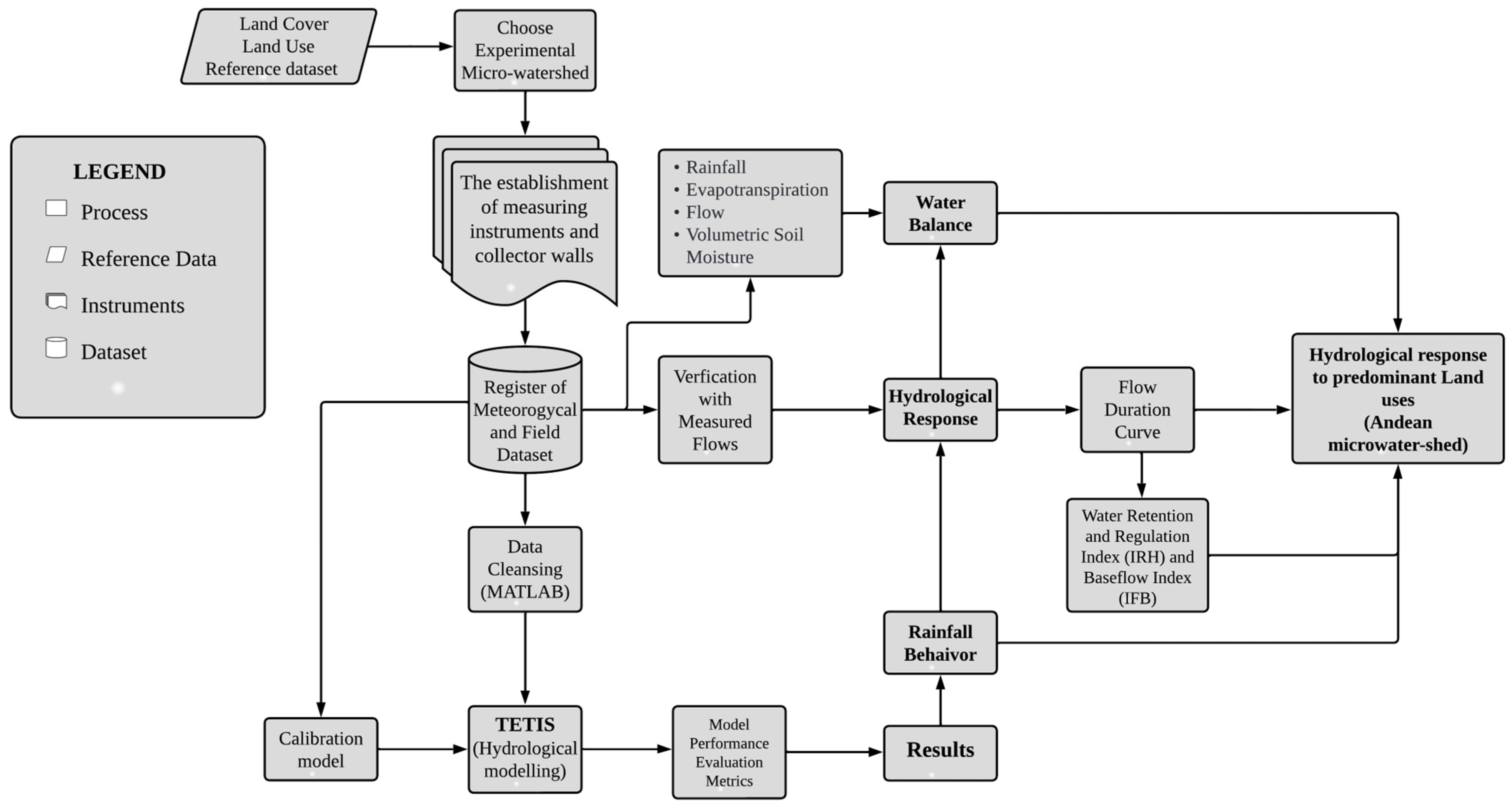
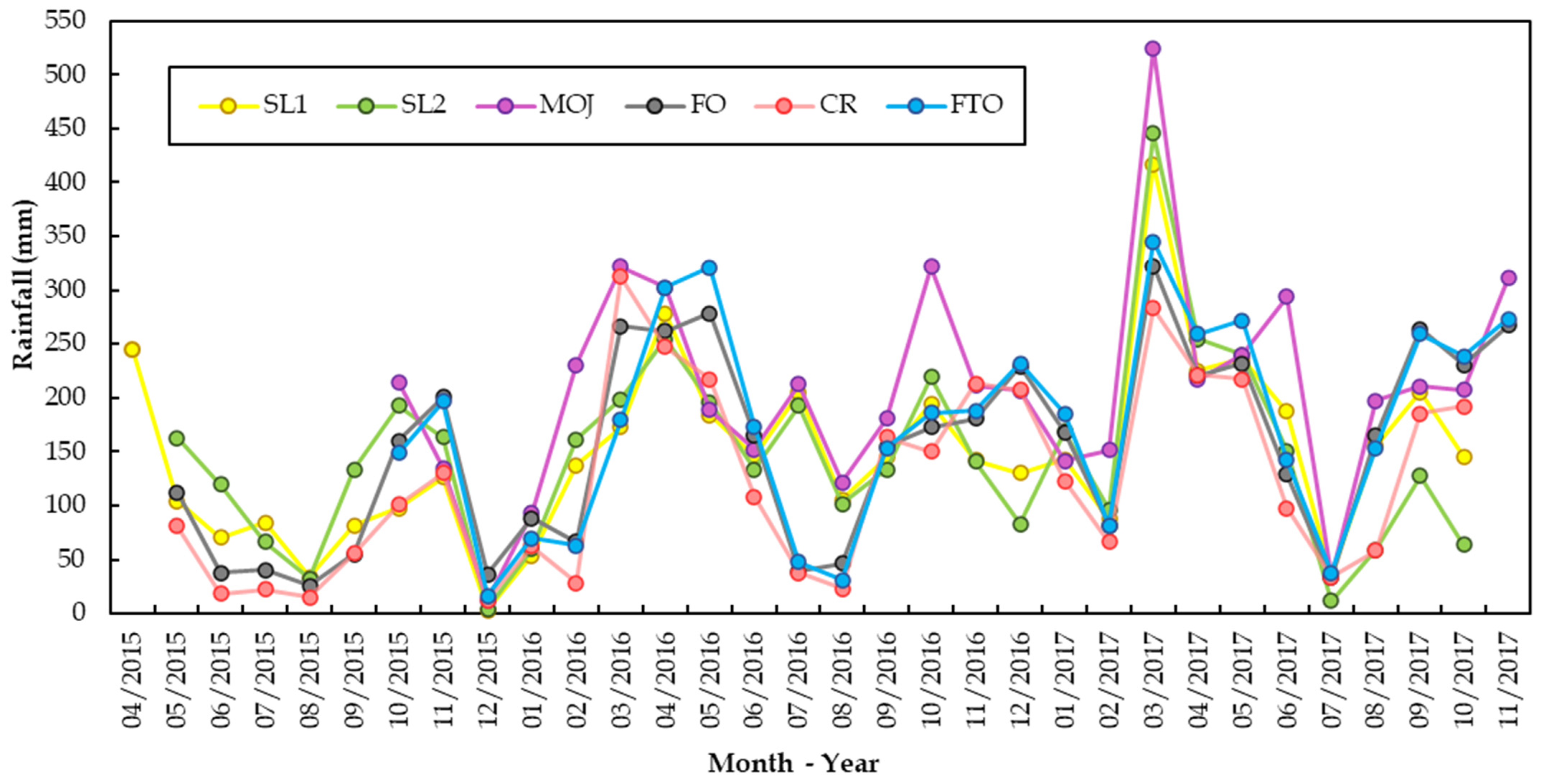
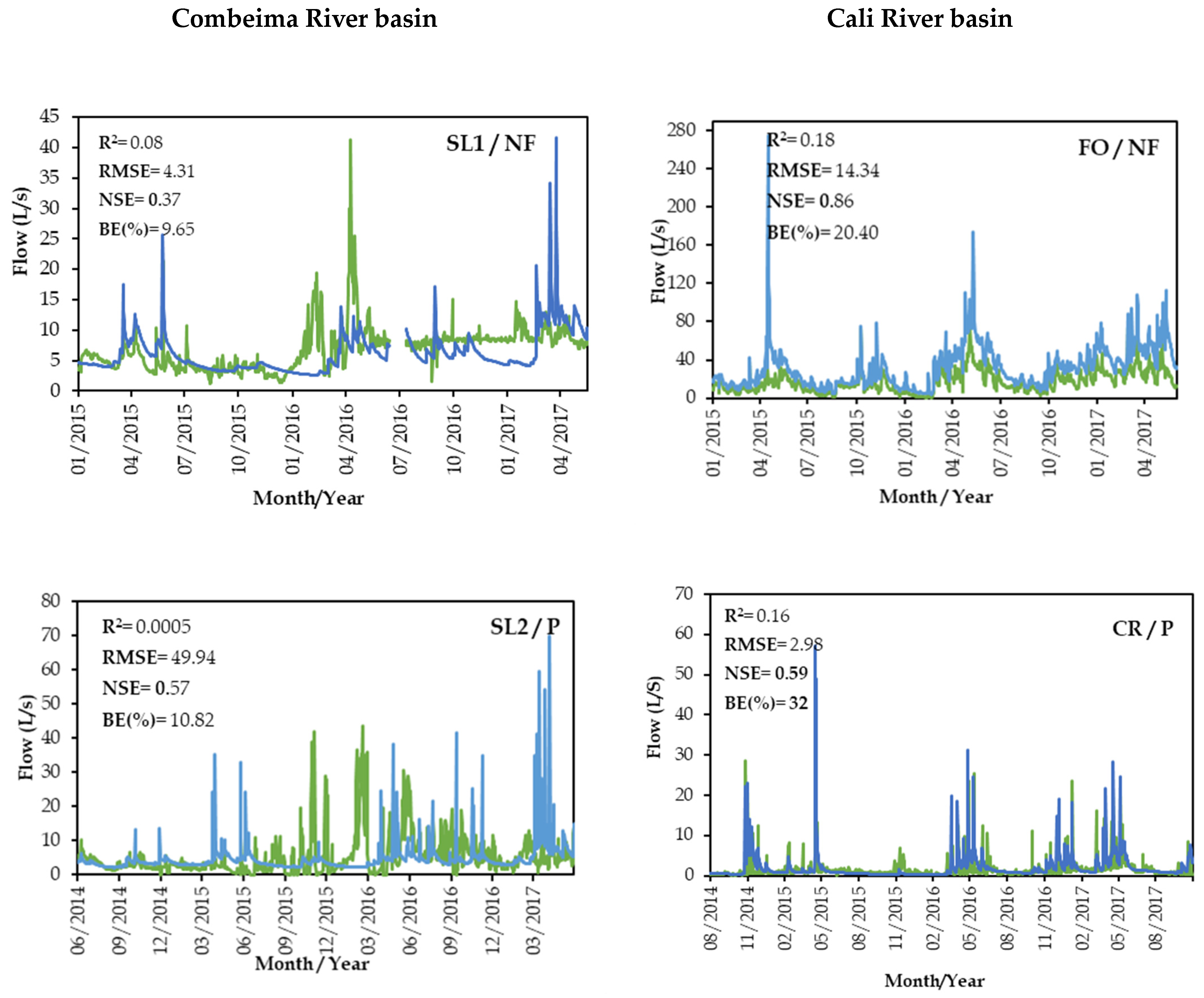


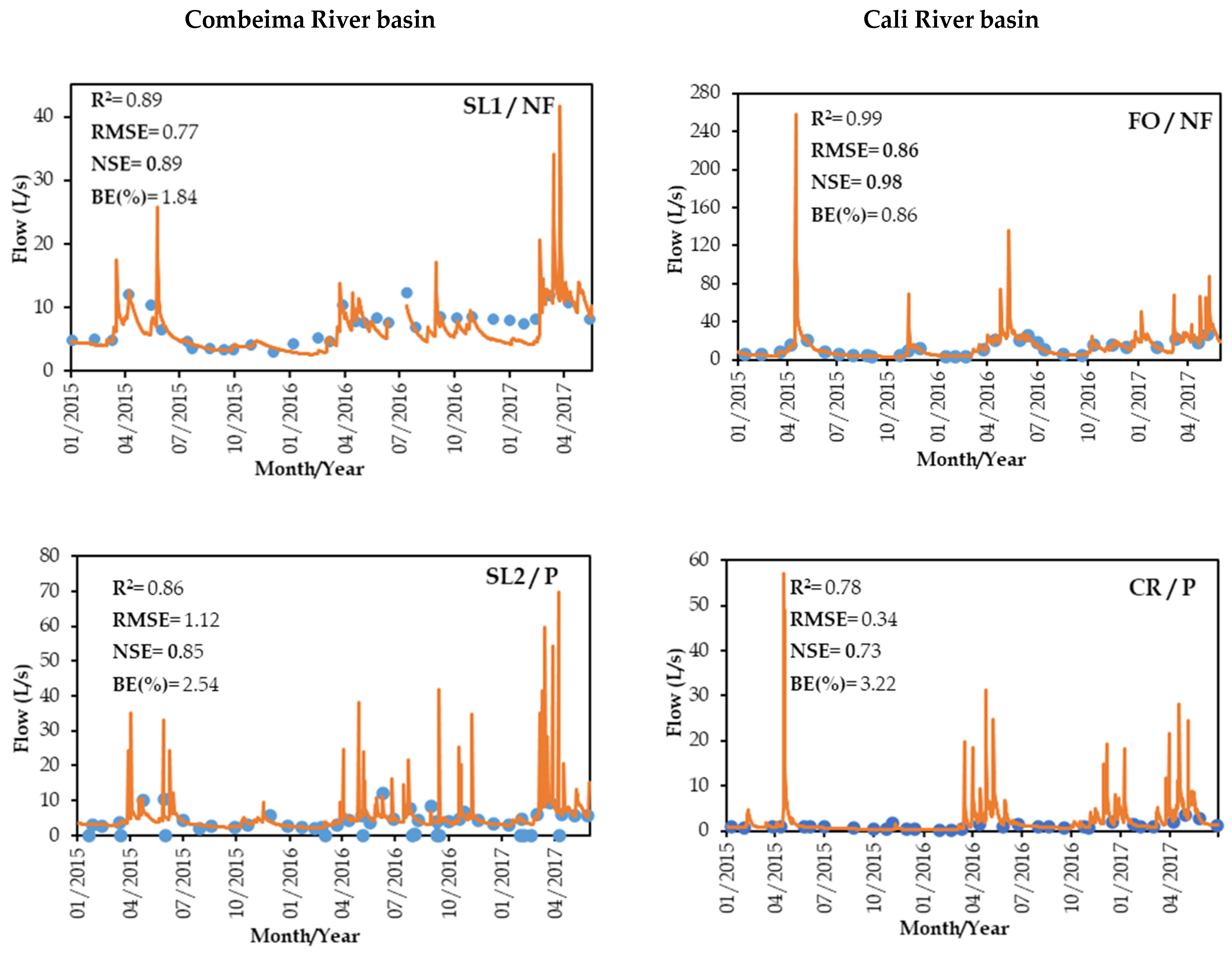
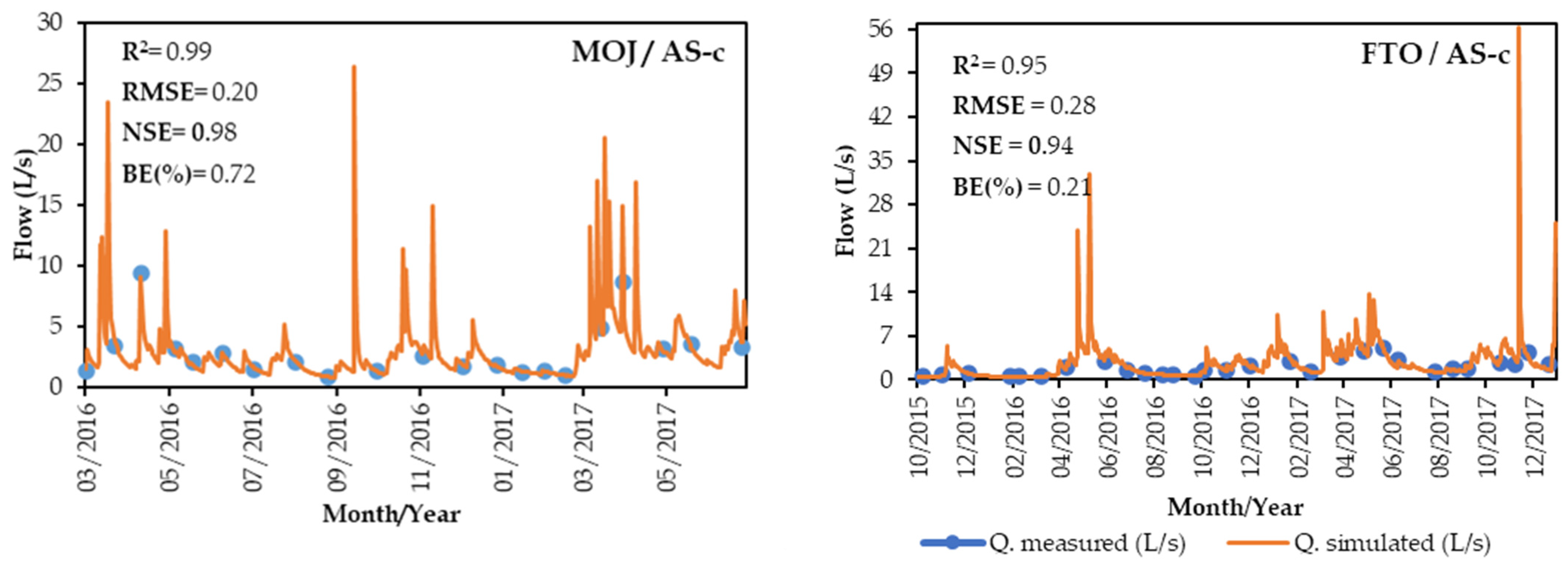



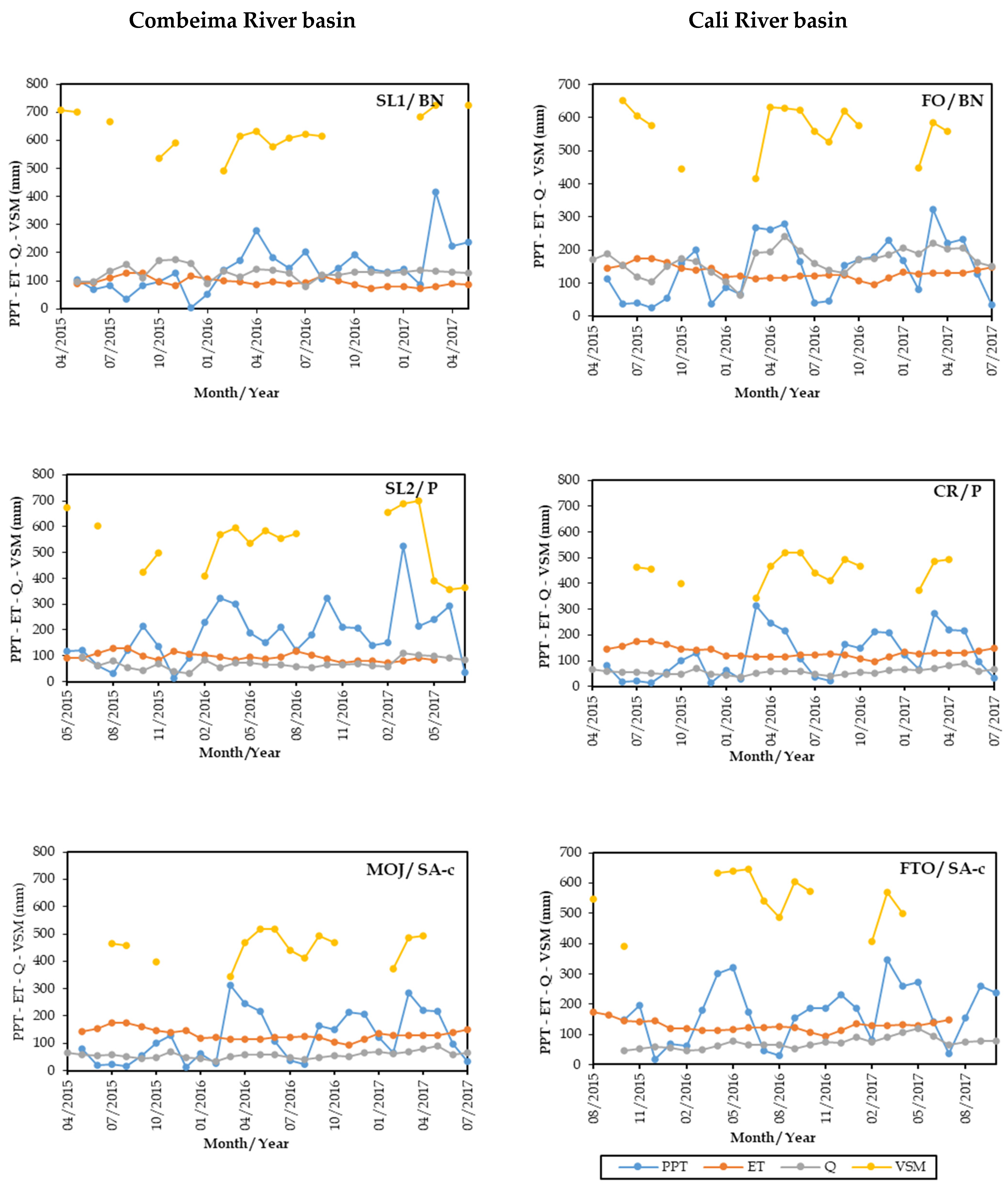
| EMs (LULC) | Area (ha) | Coordinates | Altitudinal Range (m a.s.l.) | |
|---|---|---|---|---|
| North | West | |||
| Combeima River Basin | ||||
| SL1 (NF) | 22.8 | 4° 29.178′ N | 75° 15.284′ W | 1932–2322 |
| 4° 29.443′ N | 75° 15.306′ W | |||
| SL2 (P) | 16.3 | 4° 29.294′ N | 75° 15.657′ W | 1928–2244 |
| 4° 29.323′ N | 75° 15.396′ W | |||
| MOJ (AS-c) | 10.8 | 4° 28.972′ N | 75° 15.270′ W | 1590–1830 |
| 4° 28.159′ N | 75° 15.149′ W | |||
| Cali River Basin | ||||
| FO (NF) | 51.5 | 3° 25.468′ N | 76° 36.086′ W | 1484–1764 |
| 3° 25.425′ N | 76° 35.646′ W | |||
| CR (P) | 16.5 | 3° 25.777′ N | 76° 34.540′ W | 1266–1386 |
| 3° 25.818′ N | 76° 34.782′ W | |||
| FTO (AS-c) | 10.5 | 3° 25.591′ N | 76° 35.837′ W | 1524–1692 |
| 3° 25.573′ N | 76° 35.615′ W | |||
| EMs | Pp (mm) | Tm (°C) | RH (%) | S | PM | ST | LULC | Life Zone |
|---|---|---|---|---|---|---|---|---|
| Combeima River Basin | ||||||||
| SL1 | 1578.1 ± 37.6 | 20.8 | 79.5 | Steep | Granodiorite | Typic Eutrodepts | Natural forest (NF) | TP-mf |
| SL2 | 1730.6 ± 20.9 | 20.8 | 79.5 | Pasture (P) | ||||
| MOJ | 2353.5 ± 23.0 | 20.8 | 79.5 | Coffee agroforestry system (AS-c) | ||||
| Cali River Basin | ||||||||
| FO | 1594.6 ± 71.1 | 25.4 | 70.6 | Moderately Steep | Lateritic Basalt | Typic Haplustalfs | Natural forest (NF) | (T-df) |
| CR | 1340 ± 55.4 | 25.4 | 70.6 | Pasture (P) | ||||
| FTO | 1892.4 ± 62.5 | 25.4 | 70.6 | Coffee agroforestry system (AS-c) | ||||
| Input Variables | Combeima River Basin | Cali River Basin | Reference Values | ||||||
|---|---|---|---|---|---|---|---|---|---|
| Micro-Basins | Micro-Basins | ||||||||
| SL1 | SL2 | MOJ | FO | CR | FTO | Min | Max | ||
| Initial conditions | Capillary storage | 70 | 60 | 70 | 60 | 60 | 80 | 25 | 100 |
| Surface water storage | 0 | 0 | 0 | 0 | 0 | 0 | 0 | 0 | |
| Upper gravitational Z storage | 5 | 5 | 10 | 15 | 15 | 15 | 5 | 22 | |
| Lower gravitational Z storage (aquifer) | 120 | 150 | 100 | 150 | 100 | 200 | 120 | 600 | |
| Parameters | Capillary storage (mm/day) | 180 | 160 | 160 | 180 | 160 | 160 | 50 | 200 |
| Top layer conductivity (mm/day) | 26 | 18 | 22 | 24 | 20 | 26 | 7.5 | 30 | |
| Bottom layer conductivity (mm/day) | 8 | 8 | 6 | 4 | 7 | 6 | 2.5 | 10 | |
| Underground losses (mm) | 0 | 0 | 1 | 0 | 3 | 0 | 0 | 0 | |
| Surface flow average residence time (days) | 2 | 1 | 1.5 | 1.5 | 1.1 | 1.5 | 1 | 2 | |
| Mean subsurface flow residence time (days) | 15 | 10 | 10 | 15 | 5 | 10 | 2.5 | 10 | |
| Baseflow average residence time (days) | 150 | 150 | 150 | 200 | 120 | 150 | 50 | 200 | |
| EMs/LULC | Pm (mm/Year) | Qmdobs (L/s) | Qmdsim (L/s) | Qmindobs (L/s) | Qmindsim (L/s) | Qmaxdobs (L/s) | Qmaxdsim (L/s) |
|---|---|---|---|---|---|---|---|
| Cuenca Río Combeima | |||||||
| SL1/NF | 1578.1 ± 37.62 | 6.85 | 6.26 | 1.18 | 2.6 | 41.31 | 41.59 |
| SL2/P | 1730.65 ± 20.86 | 5.37 | 4.79 | 0.02 | 2.14 | 43.5 | 69.8 |
| MOJ/AS-c | 2353.55 ± 23.05 | 2.51 | 2.79 | 0.04 | 0.42 | 16.46 | 26.38 |
| Cuenca Río Cali | |||||||
| FO/NF | 1594.65 ± 71.10 | 17.87 | 14.23 | 0.19 | 3.08 | 85.4 | 258.61 |
| CR/P | 1340 ± 55.37 | 1.54 | 2.02 | 0.1 | 0.15 | 35.87 | 57.15 |
| FTO/AS-c | 1892.45 ± 62.55 | 2.71 | 2.04 | 0.2 | 0.34 | 61.13 | 40.85 |
| EMs/LULC | Tetis Model Performance Assessment Metrics | |||||||
|---|---|---|---|---|---|---|---|---|
| Calibrated Model | Verified Model | |||||||
| R2 | RMSE | NSE | BE (%) | R2 | RMSE | NSE | BE (%) | |
| SL1/NF | 0.08 | 4.31 | 0.37 | 9.65 | 0.89 | 0.77 | 0.89 | 1.84 |
| SL2/P | 0.0005 | 49.64 | 0.57 | 10.82 | 0.86 | 1.12 | 0.85 | 2.54 |
| MOJ/AS-c | 0.18 | 2.80 | 0.48 | 20.60 | 0.99 | 0.20 | 0.98 | 0.72 |
| FO/NF | 0.18 | 14.34 | 0.86 | 20.40 | 0.99 | 0.86 | 0.98 | 0.86 |
| CR/P | 0.16 | 2.98 | 0.59 | 32.00 | 0.78 | 0.34 | 0.73 | 3.22 |
| FTO/AS-c | 0.28 | 3.32 | 0.093 | 1.02 | 0.95 | 0.28 | 0.94 | 0.21 |
Disclaimer/Publisher’s Note: The statements, opinions and data contained in all publications are solely those of the individual author(s) and contributor(s) and not of MDPI and/or the editor(s). MDPI and/or the editor(s) disclaim responsibility for any injury to people or property resulting from any ideas, methods, instructions or products referred to in the content. |
© 2024 by the authors. Licensee MDPI, Basel, Switzerland. This article is an open access article distributed under the terms and conditions of the Creative Commons Attribution (CC BY) license (https://creativecommons.org/licenses/by/4.0/).
Share and Cite
Sánchez, H.G.; Loaiza Usuga, J.C.; Vélez Upégui, J.I. Hydrological Response to Predominant Land Use and Land Cover in the Colombian Andes at the Micro-Watershed Scale. Land 2024, 13, 1140. https://doi.org/10.3390/land13081140
Sánchez HG, Loaiza Usuga JC, Vélez Upégui JI. Hydrological Response to Predominant Land Use and Land Cover in the Colombian Andes at the Micro-Watershed Scale. Land. 2024; 13(8):1140. https://doi.org/10.3390/land13081140
Chicago/Turabian StyleSánchez, Henry Garzón, Juan Carlos Loaiza Usuga, and Jaime Ignacio Vélez Upégui. 2024. "Hydrological Response to Predominant Land Use and Land Cover in the Colombian Andes at the Micro-Watershed Scale" Land 13, no. 8: 1140. https://doi.org/10.3390/land13081140






